Development of Basalt Fiber Reinforced Fine-Grained Cementitious Composites for Textile Reinforcements
Abstract
1. Introduction
2. Materials and Methods
2.1. Materials
2.2. Specimen Preparation
2.3. Methods
2.3.1. Fresh Properties
2.3.2. Mechanical Properties
Compressive Strength Test
Split Tensile Test
Flexural Test
Impact Resistance Test
Dynamic Modulus of Elasticity
2.3.3. Microstructural Characteristics
3. Results and Discussion
3.1. Fresh Properties-Flow Table Test
3.2. Mechanical Properties
3.2.1. Compressive Strength
3.2.2. Split Tensile Strength
3.2.3. Flexural Strength
3.2.4. Impact Resistance
3.2.5. Dynamic Modulus of Elasticity
3.3. Microstructural Properties
3.3.1. SEM with EDS
3.3.2. FTIR
4. Conclusions
Author Contributions
Funding
Data Availability Statement
Acknowledgments
Conflicts of Interest
References
- Chen, B.; Du, L.; Yuan, J.; Sun, X.; Pathirage, M.; Sun, W.; Feng, J. A Experimental Study on Engineered Cementitious Composites (ECC) Incorporated with Sporosarcina Pasteurii. Buildings 2022, 12, 691. [Google Scholar] [CrossRef]
- Markou, I. Effect of Grain Shape and Size on the Mechanical Behavior of Reinforced Sand. Procedia Eng. 2016, 143, 146–152. [Google Scholar] [CrossRef]
- Zajceva, L.; Lucyk, E.; Latypova, T.; Latypov, V.; Fedorov, P.; Salamanova, M. Influence of the Type of Aggregate from Industrial Waste on Corrosion Resistance of Modified Fine-Grained Concrete. Buildings 2021, 11, 352. [Google Scholar] [CrossRef]
- Brockmann, T. Mechanical and Fracture Mechanical Properties of Fine-grained Concrete for TRC Structures. In Advances in Construction Materials 2007; Grosse, C.U., Ed.; Springer: Berlin/Heidelberg, Germany, 2007; pp. 119–129. ISBN 978-3-540-72447-6. [Google Scholar]
- Nizina, T.A.; Ponomarev, A.N.; Balykov, A.S.; Pankin, N.A. Fine-Grained Fibre Concretes Modified by Complexed Nanoadditives. IJNT 2017, 14, 665. [Google Scholar] [CrossRef]
- Daskiran, E.G.; Daskiran, M.M.; Gencoglu, M. Development of Fine-grained Concretes for Textile Reinforced Cementitious Composites. Comput. Concr. 2016, 18, 279–295. [Google Scholar] [CrossRef]
- Lesovik, R.; Klyuyev, S.; Klyuyev, A.; Tolbatov, A.; Durachenko, A. The Development of Textile Fine-Grained Fiber Concrete Using Technogenic Raw Materials. Res. J. Appl. Sci. 2015, 10, 701–706. [Google Scholar]
- Klyuev, S.; Klyuev, A.; Abakarov, A.; Shorstova, E.; Gafarova, N. The Effect of Particulate Reinforcement on Strength and Deformation Characteristics of Fine-Grained Concrete. Mag. Civ. Eng. 2017, 7, 66–75. [Google Scholar] [CrossRef]
- Wang, X.; Sun, K.; Shao, J.; Ma, J. Study on Mechanical and Rheological Properties of Solid Waste-Based ECC. Buildings 2022, 12, 1690. [Google Scholar] [CrossRef]
- Haido, J.H. Flexural Behavior of Basalt Fiber Reinforced Concrete Beams: Finite Element Simulation with New Constitutive Relationships. Structures 2020, 27, 1876–1889. [Google Scholar] [CrossRef]
- Scholzen, A.; Chudoba, R.; Hegger, J. Thin-Walled Shell Structures Made of Textile-Reinforced Concrete: Part I: Structural Design and Construction. Struct. Concr. 2015, 16, 106–114. [Google Scholar] [CrossRef]
- Dhand, V.; Mittal, G.; Rhee, K.Y.; Park, S.-J.; Hui, D. A Short Review on Basalt Fiber Reinforced Polymer Composites. Compos. Part B Eng. 2015, 73, 166–180. [Google Scholar] [CrossRef]
- Smarzewski, P. Comparative Fracture Properties of Four Fibre Reinforced High Performance Cementitious Composites. Materials 2020, 13, 2612. [Google Scholar] [CrossRef] [PubMed]
- Hong, L.; Chen, Y.D.; Li, T.D.; Gao, P.; Sun, L.Z. Microstructure and Bonding Behavior of Fiber-Mortar Interface in Fiber-Reinforced Concrete. Constr. Build. Mater. 2020, 232, 117235. [Google Scholar] [CrossRef]
- Loh, Z.P.; Mo, K.H.; Tan, C.G.; Yeo, S.H. Mechanical Characteristics and Flexural Behaviour of Fibre-Reinforced Cementitious Composite Containing PVA and Basalt Fibres. Sādhanā 2019, 44, 98. [Google Scholar] [CrossRef]
- Barhum, R.; Mechtcherine, V. Effect of Short Fibres on Fracture Behaviour of Textile Reinforced Concrete. Carbon 2010, 7, 1498–1503. [Google Scholar]
- Xu, J.; Kang, A.; Wu, Z.; Xiao, P.; Gong, Y. Effect of High-Calcium Basalt Fiber on the Workability, Mechanical Properties and Microstructure of Slag-Fly Ash Geopolymer Grouting Material. Constr. Build. Mater. 2021, 302, 124089. [Google Scholar] [CrossRef]
- Jiang, C.; Fan, K.; Wu, F.; Chen, D. Experimental Study on the Mechanical Properties and Microstructure of Chopped Basalt Fibre Reinforced Concrete. Mater. Des. 2014, 58, 187–193. [Google Scholar] [CrossRef]
- Ahmad, M.R.; Chen, B. Effect of Silica Fume and Basalt Fiber on the Mechanical Properties and Microstructure of Magnesium Phosphate Cement (MPC) Mortar. Constr. Build. Mater. 2018, 190, 466–478. [Google Scholar] [CrossRef]
- Sun, X.; Gao, Z.; Cao, P.; Zhou, C. Mechanical Properties Tests and Multiscale Numerical Simulations for Basalt Fiber Reinforced Concrete. Constr. Build. Mater. 2019, 202, 58–72. [Google Scholar] [CrossRef]
- Li, M.; Gong, F.; Wu, Z. Study on Mechanical Properties of Alkali-Resistant Basalt Fiber Reinforced Concrete. Constr. Build. Mater. 2020, 245, 118424. [Google Scholar] [CrossRef]
- IS 12269 (2013); Specification for 53 Grade Ordinary Portland Cement (BI-LINGUAL). Bureau of Indian Standards: New Delhi India, 2013.
- IS 383 (2016); Specification for Coarse and Fine Aggregates From Natural Sources For Concrete. Bureau of Indian Standards: New Delhi, India, 2016.
- ASTM 1437; Standard Test Method for Flow of Hydraulic Cement Mortar. ASTM Int.: West Conshohocken, PA, USA, 2001.
- IS 5816 (1999); Method of Test Splitting Tensile Strength of Concrete. Bureau of Indian Standards: New Delhi, India, 1999.
- ASTM C 230; Standard Specification for Flow Table for Use in Tests of Hydraulic Cement. ASTM Int.: West Conshohocken, PA, USA, 1997.
- ACI 544.2R-89; Measurement of Properties of Fiber Reinforced Concrete. ACI Comm.: Kent, WA, USA, 2018.
- Al-Baijat, H. Dynamic Modulus of Elasticity of Some Mortars Prepared from Selected Jordanian Masonry Cements. OJCM 2019, 9, 199–206. [Google Scholar] [CrossRef][Green Version]
- Lydon, F.D.; Iacovou, M. Some Factors Affecting the Dynamic Modulus of Elasticity of High Strength Concrete. Cem. Concr. Res. 1995, 25, 1246–1256. [Google Scholar] [CrossRef]
- Cohen, M.D.; Lee, T.-F.F.; Goldman, A. A Method for Estimating the Dynamic Moduli of Cement Paste-Aggregate Interfacial Zones in Mortar. MRS Proc. 1994, 370, 407. [Google Scholar] [CrossRef]
- IS 13311-1 (1992); Method of Non-Destructive Testing of Concret, Part 1: Ultrasonic Pulse Velocity. Bureau of Indian Standards: New Delhi, India, 1992.
- Girgin, Z.C. Usability of Basalt Fibres in Fibre Reinforced Cement Composites. Mater. Struct. 2016, 49, 3309–3319. [Google Scholar] [CrossRef]
- Özkan, Ş.; Demir, F. The Hybrid Effects of PVA Fiber and Basalt Fiber on Mechanical Performance of Cost Effective Hybrid Cementitious Composites. Constr. Build. Mater. 2020, 263, 120564. [Google Scholar] [CrossRef]
- IS 4031-6 (1988); Methods of Physical Tests for Hydraulic Cement, Part 6: Determination of Compressive Strength of Hydraulic Cement (Other than Masonry Cement). Bureau of Indian Standards: New Delhi, India, 1988.
- Asprone, D.; Cadoni, E.; Iucolano, F.; Prota, A. Analysis of the Strain-Rate Behavior of a Basalt Fiber Reinforced Natural Hydraulic Mortar. Cem. Concr. Compos. 2014, 53, 52–58. [Google Scholar] [CrossRef]
- Rafiei, P.; Shokravi, H.; Mohammadyan-Yasouj, S.E.; Koloor, S.S.R.; Petrů, M. Temperature Impact on Engineered Cementitious Composite Containing Basalt Fibers. Appl. Sci. 2021, 11, 6848. [Google Scholar] [CrossRef]
- Du, Q.; Cai, C.; Lv, J.; Wu, J.; Pan, T.; Zhou, J. Experimental Investigation on the Mechanical Properties and Microstructure of Basalt Fiber Reinforced Engineered Cementitious Composite. Materials 2020, 13, 3796. [Google Scholar] [CrossRef]
- Wille, K.; Naaman, A.E.; El-Tawil, S.; Parra-Montesinos, G.J. Ultra-High Performance Concrete and Fiber Reinforced Concrete: Achieving Strength and Ductility without Heat Curing. Mater. Struct. 2012, 45, 309–324. [Google Scholar] [CrossRef]
- Alavi Nia, A.; Hedayatian, M.; Nili, M.; Sabet, V.A. An Experimental and Numerical Study on How Steel and Polypropylene Fibers Affect the Impact Resistance in Fiber-Reinforced Concrete. Int. J. Impact Eng. 2012, 46, 62–73. [Google Scholar] [CrossRef]
- Carrillo, J.; Ramirez, J.; Lizarazo-Marriaga, J. Modulus of Elasticity and Poisson’s Ratio of Fiber-Reinforced Concrete in Colombia from Ultrasonic Pulse Velocities. J. Build. Eng. 2019, 23, 18–26. [Google Scholar] [CrossRef]
- Fjær, E. Static and Dynamic Moduli of a Weak Sandstone. GEOPHYSICS 2009, 74, WA103–WA112. [Google Scholar] [CrossRef]
- Ahmad, M.R.; Chen, B. Microstructural Characterization of Basalt Fiber Reinforced Magnesium Phosphate Cement Supplemented by Silica Fume. Constr. Build. Mater. 2020, 237, 117795. [Google Scholar] [CrossRef]
- Punurai, W.; Kroehong, W.; Saptamongkol, A.; Chindaprasirt, P. Mechanical Properties, Microstructure and Drying Shrinkage of Hybrid Fly Ash-Basalt Fiber Geopolymer Paste. Constr. Build. Mater. 2018, 186, 62–70. [Google Scholar] [CrossRef]
- De Pellegrin, M.Z.; Acordi, J.; Montedo, O.R.K. Influence of the Length and the Content of Cellulose Fibers Obtained from Sugarcane Bagasse on the Mechanical Properties of Fiber-Reinforced Mortar Composites. J. Nat. Fibers 2021, 18, 111–121. [Google Scholar] [CrossRef]



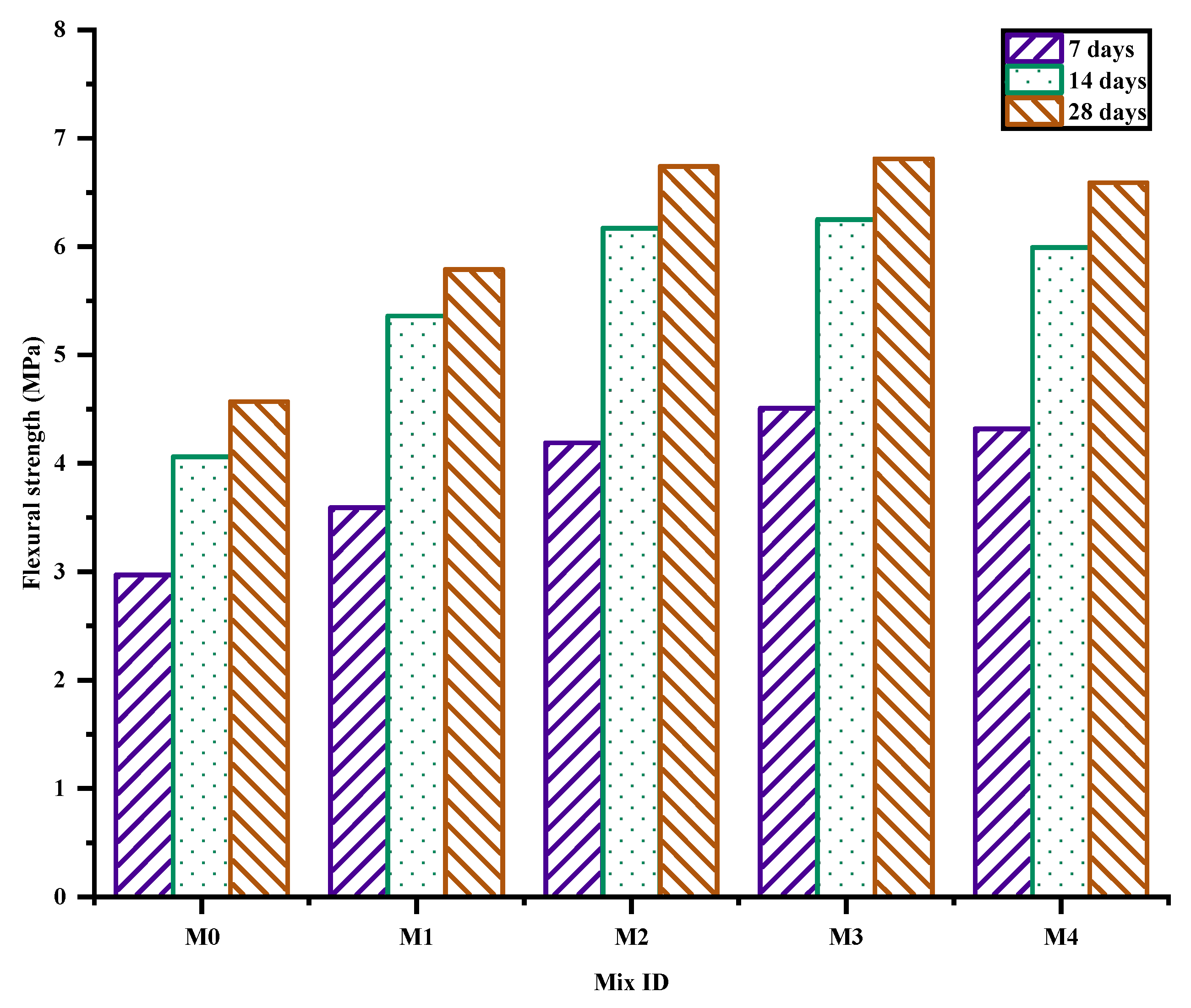
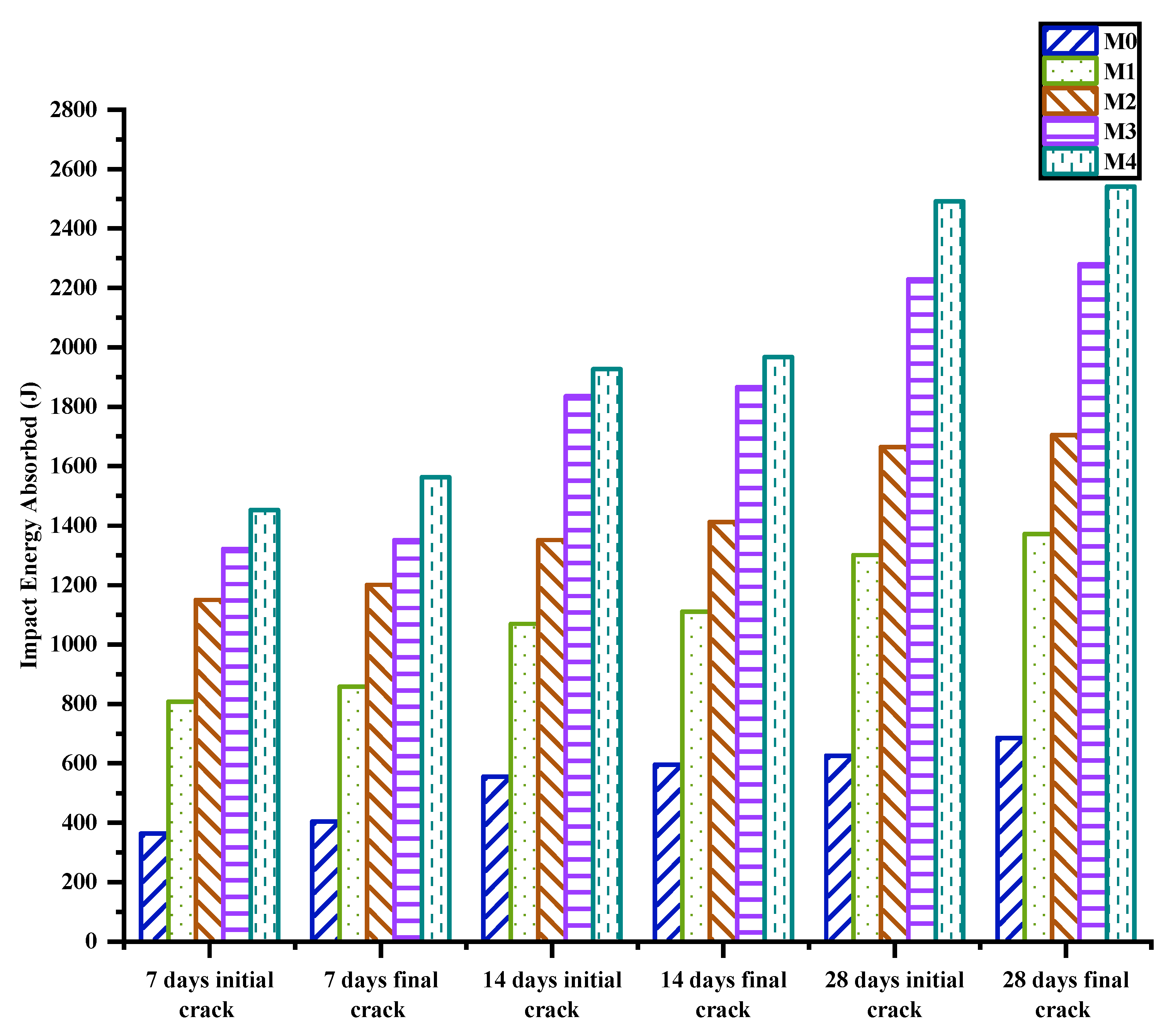

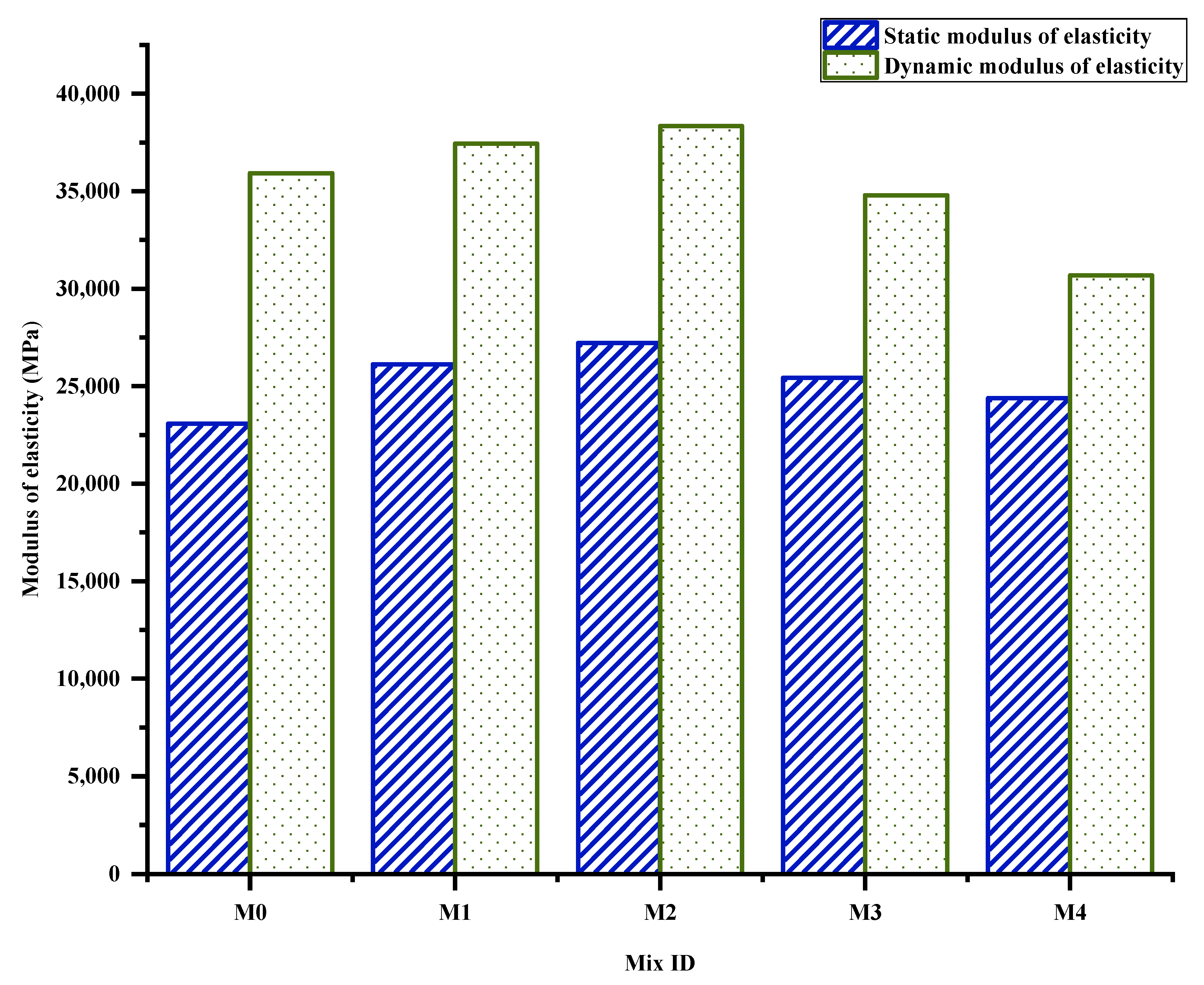
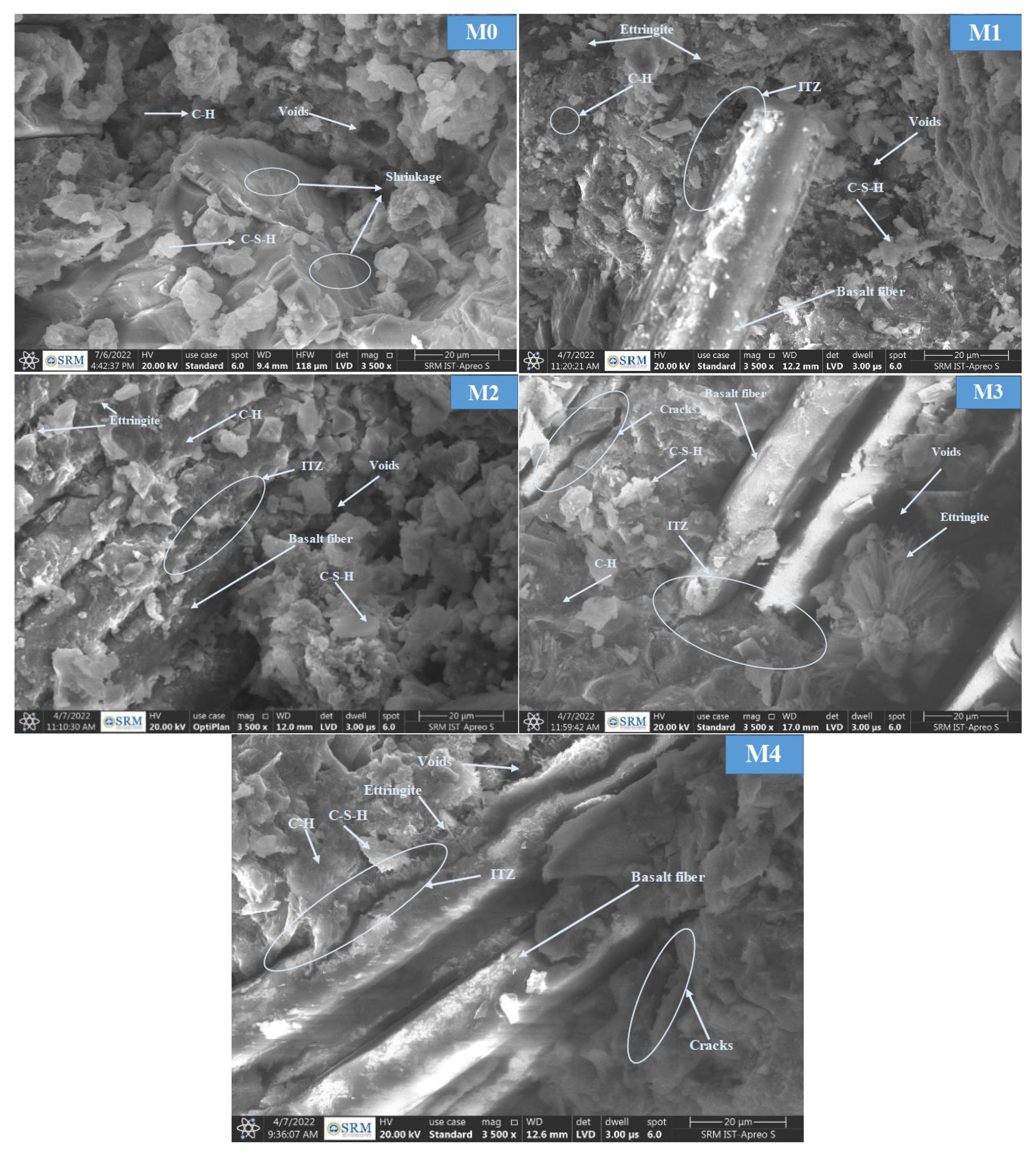
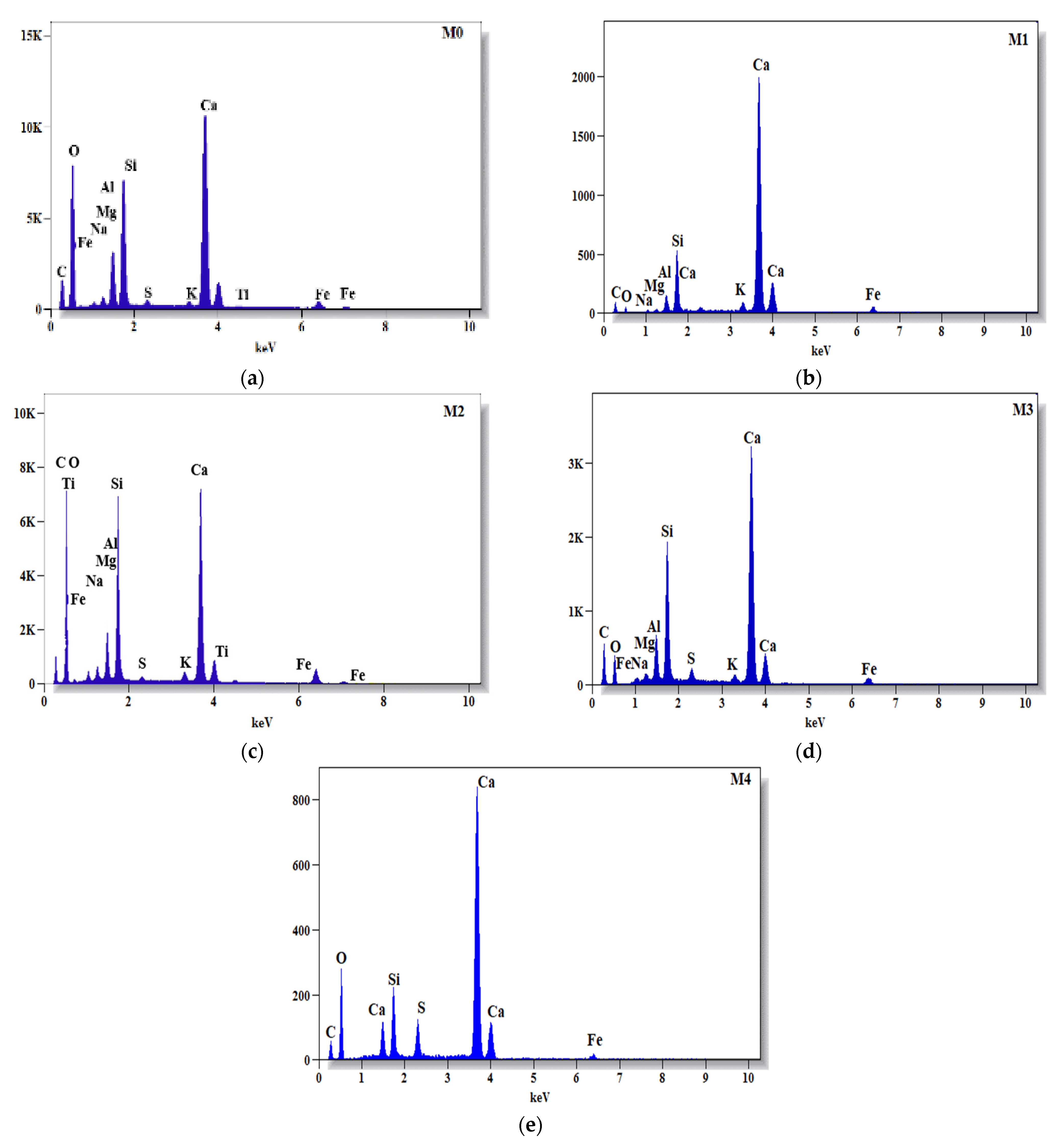

| Properties | Cement | Fine Aggregate | Superplasticizer |
|---|---|---|---|
| Specific gravity | 3.1 | 2.74 | 1.18 |
| Grading of M-sand | - | Zone III (slightly fine) | - |
| Density (kg/m3) | 1420 | 1790 | - |
| Property | Values |
|---|---|
| Density | 2.68 (g/cm3) |
| Length | 12 mm |
| Fiber diameter | 16 μm |
| Aspect ratio | 705 |
| Tensile strength | 3.57 GPa |
| Elastic modulus | 88 GPa |
| Elongation at break | 3.16% |
| Mix ID | % Basalt Fiber | Cement (kg/m3) | Fine Aggregate (kg/m3) | Water (kg/m3) | Basalt Fiber (kg/m3) | Super Plasticizer (kg/m3) |
|---|---|---|---|---|---|---|
| M0 | 0 | 454.8 | 1654.35 | 191.55 | - | 4.54 |
| M1 | 0.2 | 2.67 | ||||
| M2 | 0.4 | 5.34 | ||||
| M3 | 0.5 | 6.68 | ||||
| M4 | 1 | 13.35 |
Publisher’s Note: MDPI stays neutral with regard to jurisdictional claims in published maps and institutional affiliations. |
© 2022 by the authors. Licensee MDPI, Basel, Switzerland. This article is an open access article distributed under the terms and conditions of the Creative Commons Attribution (CC BY) license (https://creativecommons.org/licenses/by/4.0/).
Share and Cite
Sudhakar, A.J.; Muthusubramanian, B. Development of Basalt Fiber Reinforced Fine-Grained Cementitious Composites for Textile Reinforcements. J. Compos. Sci. 2022, 6, 396. https://doi.org/10.3390/jcs6120396
Sudhakar AJ, Muthusubramanian B. Development of Basalt Fiber Reinforced Fine-Grained Cementitious Composites for Textile Reinforcements. Journal of Composites Science. 2022; 6(12):396. https://doi.org/10.3390/jcs6120396
Chicago/Turabian StyleSudhakar, Alein Jeyan, and Bhuvaneshwari Muthusubramanian. 2022. "Development of Basalt Fiber Reinforced Fine-Grained Cementitious Composites for Textile Reinforcements" Journal of Composites Science 6, no. 12: 396. https://doi.org/10.3390/jcs6120396
APA StyleSudhakar, A. J., & Muthusubramanian, B. (2022). Development of Basalt Fiber Reinforced Fine-Grained Cementitious Composites for Textile Reinforcements. Journal of Composites Science, 6(12), 396. https://doi.org/10.3390/jcs6120396






